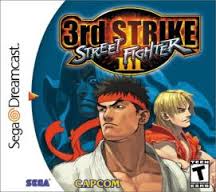Personal Favorite: STREET FIGHTER III: THIRD STRIKE
Over the years of both arcade and console gaming the Street Fighter franchise has solidified itself as the best in the 2D fighter business. Following the many different versions of Street Fighter II, Capcom  released Street Fighter III to arcades. The game wasn’t nearly as successful (or as good in my opinion) as its predecessor. After a second try with Street Fighter III: 2nd Impact, the game still saw only small success. It would turn out that third time is the charm though, as in 1999 Street Fighter III: Third Strike came to arcades and Sega Dreamcast. While sales were still low, feedback from fighting game fans was overwhelmingly positive and the game still remains a cult hit even to this day.
released Street Fighter III to arcades. The game wasn’t nearly as successful (or as good in my opinion) as its predecessor. After a second try with Street Fighter III: 2nd Impact, the game still saw only small success. It would turn out that third time is the charm though, as in 1999 Street Fighter III: Third Strike came to arcades and Sega Dreamcast. While sales were still low, feedback from fighting game fans was overwhelmingly positive and the game still remains a cult hit even to this day.
I should start off with letting you know a not well kept secret: I am a huge fighting game fan, particularly Street Fighter. I’ve had great success and fun with guides and YouTube videos within the fighting game community. You may think that makes me biased towards a game, but I would actually argue I’m even harder on Street Fighter games than other fighters because I’ve come to expect so much from Capcom over the last two decades. Third Strike‘s cover art showcases the cast in a not too exciting layout. Gameplay itself is visually impressive. With a 2.5D look, clean edges and fluent animations. Sound effects are excellent, parries sound satisfying and the sound track is decent.
What makes the game play of Third Strike different from other Street Fighter games is the parry system and its take on the super meter system. In Street Fighter games there is a super bar which fills up as a character takes damage and deals damage. Once full, players can spend that bar on a high damage, special mechanics laden Super attack which is typically unique to that character. In Third Strike each character has a variable number of super bars that are also of a variable length. They also have multiple options of supers to choose from per character, adding even more depth to match-ups. Instead of using an entire bar for a super, characters can also spend Super meter on EX moves which are upgraded versions of their unique special moves. The parry system allows the player to tap the joystick towards their opponent at the exact moment they would be hit. If the timing is precise and the player also correctly guessed it to be a high or low attack then the attack is parried. A successful parry lets your character avoid all recovery frames they would’ve spent blocking, allowing them to freely retaliate on their opponent. The parry system adds an immeasurable amount of depth and skill to Third Strike, making it the most technical and difficult Street Fighter game in most fan’s eyes.
The main issue with Third Strike is it was never well balanced (meaning the tools and overall usefulness of each character isn’t close enough to being balanced across the cast). Well let me rephrase that, it was as balanced as most fighting games, but it didn’t match the really good track record Street Fighter games have had in cast balance. To the average gamer the level of balance Third Strike has is probably more than adequate. To fighting gamers who mainly play Street Fighter games the balance issue is quite noticeable and well-known. A third of the cast is all but unusable in high level tournaments. Again, that’s typical for most fighters, but not what we’ve come to expect from Capcom fighters.
Overall Third Strike is one of the favorite fighters ever among die-hard fighting gamers as its parry system, personality, skill gap and high technical level make for a hardcore fighting gamer’s wet dream. If the cast was more balanced I believe it might’ve been the best fighting game ever. With studios moving towards more beginner friendly mechanics in their fighting games we may never see another Street Fighter title with this high level of technicality. If you missed out on Third Strike, its worth the revisit.
_____________________________________
